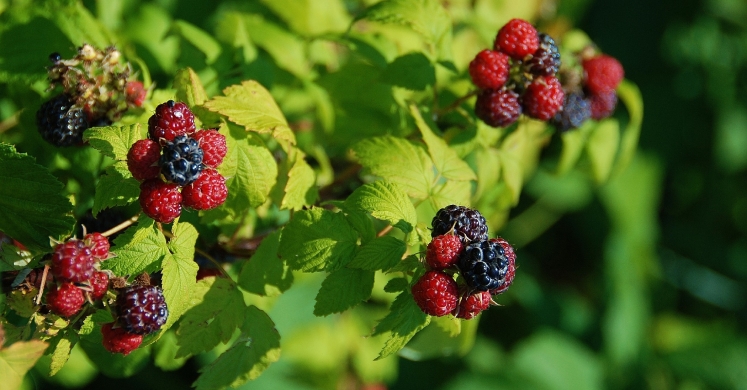Blog

#bioPGH Blog: Black Raspberries
 A resource of Biophilia: Pittsburgh, #bioPGH is a weekly blog and social media series that aims to encourage both children and adults to reconnect with nature and enjoy what each of our distinctive seasons has to offer.
A resource of Biophilia: Pittsburgh, #bioPGH is a weekly blog and social media series that aims to encourage both children and adults to reconnect with nature and enjoy what each of our distinctive seasons has to offer.
What would summer be without the sticky fingers and sweet tastes of wild black raspberry picking? Imagine a black raspberry bush and you can practically feel the warm summer sun and hear the buzzing of the mason bees, honeybees, bumblebees, and leaf-cutting bees that pollinate the flowers. Humans, birds, and other wild animals are all willing to overlook a few scratches from the brambles in pursuit of the sweet prize. Here in eastern North America, we’re most likely to encounter Rubrus occidentalis, and if you’ve ever grown raspberries in your own garden, you might have noticed that our black raspberries hybridize with our garden cultivars. Though we may love our black raspberries, and many animals rely on the plant as a food source, this prickly shrub is still ecologically important for other reasons as well. Let’s explore!
Black raspberries grow in sprawling shrubs in edge habitats—habitats on the borders of forests and meadows. You have probably identified them before by their compound leaves growing in groups of three leaflets, and if you look closely at the flowers of black raspberries, the center has dozens of pistils (the female part of a flower.) After pollination, the base of each pistil eventually becomes a tiny fruit with a seed inside. This means that each raspberry is made of dozens of little fruitlets grouped together in the familiar cap-shaped berry. These berries are an important food source for a wide variety of insects, birds, and mammals, in addition to other species that will browse on the leaves.
![]()
Rubus sp. flowers.
Black raspberry shrubs are ecologically notable as well: they are a hardy successional species. Ecological succession refers to the change in a habitat over time, particularly a habitat that has been disturbed for some reason or other but is returning to a mature ecological community. For example, picture a land area devoid of living things, whether by natural causes like a wildfire or through human activity; successional growth refers to the "succession" of plants or other living things that begin to reclaim the disturbed land. Succession often starts with smaller plants that can survive in a variety of conditions, followed by larger and more long-lasting species like trees or plants that may have more specific habitat requirements. Early successional plants like black raspberries are important because they can establish themselves and grow very quickly. They can protect slower growing plants like young trees as the plant community continues to grow and change, with larger and more diverse plants moving in, until eventually reaching a climax community like a forest of mature trees and understory plants. To explore ecological succession in more detail, check out the video below that demonstrates life growing back after the destruction of Mt. St. Helen’s.
Nature has a way of surprising us with how important even a black raspberry shrub might be. So the next time you’re enjoying a summer time snack, don’t forget that at some point in their history, even forests of large majestic trees once relied on our brambly, prickly friend to grow successfully.
Connecting to the Outdoors Tip: If you're looking for black raspberries in our are, keep in mind to look for the bushes in edge habitat - not too deep in a forested area and probably near an open area like a meadow or maintained grass. Also, be sure to rinse off your sweet finds before eating, just to be on the safe side.
Continue the Conversation: Share your nature discoveries with our community by posting to Twitter and Instagram with hashtag #bioPGH, and R.S.V.P. to attend our next Biophilia: Pittsburgh meeting.
Resources
Illinois Wildflowers: Blackraspberry
Lake Forest College: Rubrus occidentalis
Nature SciTable: Successional Change in Communities
Photo Credits: Wikimedia Commons users Ken Goulding and Denis Zastanceanu, and MaxPixel
